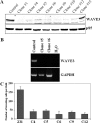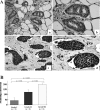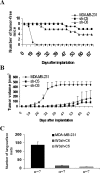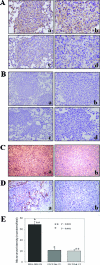Down-regulation of WAVE3, a metastasis promoter gene, inhibits invasion and metastasis of breast cancer cells
- PMID: 17525277
- PMCID: PMC1899429
- DOI: 10.2353/ajpath.2007.060975
Down-regulation of WAVE3, a metastasis promoter gene, inhibits invasion and metastasis of breast cancer cells
Abstract
The expression of WAVE3, an actin-cytoskeleton and reorganization protein, is elevated in malignant human breast cancer, yet the role of WAVE3 in promoting tumor progression remains undefined. We have recently shown that knockdown of WAVE3 expression in human breast adenocarcinoma MDA-MB-231 cells using small interfering RNA resulted in a significant reduction of cell motility, migration, and invasion, which correlated with a reduction in the levels of active p38 mitogen-activated protein kinase. Here, we investigated the effect of stable suppression of WAVE3 by short hairpin RNA on tumor growth and metastasis in xenograft models. Breast cancer MDA-MB-231 cells expressing short hairpin RNA to WAVE3 (shWAVE3) showed a significant reduction in Matrigel invasion and formation of lung colonies after tail-vein injection in SCID mice. In the orthotopic model, we observed a reduction in growth rate of the primary tumors, as well as in the metastases to the lungs. We also show that suppression of p38 mitogen-activated protein kinase activity by dominant-negative p38 results in comparable phenotypes to the knockdown of WAVE3. These studies provide direct evidence that the WAVE3-p38 pathway contributes to breast cancer progression and metastasis.
Figures







References
-
- Hanahan D, Weinberg RA. The hallmarks of cancer. Cell. 2000;100:57–70. - PubMed
-
- Friedl P, Wolf K. Tumour-cell invasion and migration: diversity and escape mechanisms. Nat Rev Cancer. 2003;3:362–374. - PubMed
-
- Billadeau DD. Cell growth and metastasis in pancreatic cancer: is Vav the Rho’d to activation? Int J Gastrointest Cancer. 2002;31:5–13. - PubMed
-
- Li Y, Tondravi M, Liu J, Smith E, Haudenschild CC, Kaczmarek M, Zhan X. Cortactin potentiates bone metastasis of breast cancer cells. Cancer Res. 2001;61:6906–6911. - PubMed
-
- Michiels F, Habets GG, Stam JC, van der Kammen RA, Collard JG. A role for Rac in Tiam1-induced membrane ruffling and invasion. Nature. 1995;375:338–340. - PubMed
Publication types
MeSH terms
Substances
Grants and funding
LinkOut - more resources
Full Text Sources
Medical
Miscellaneous

